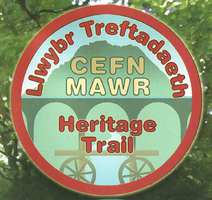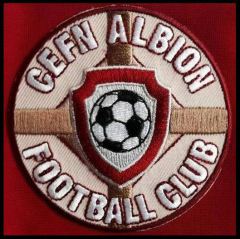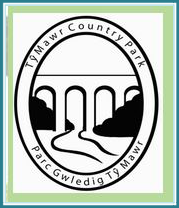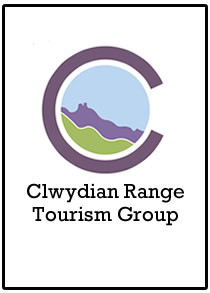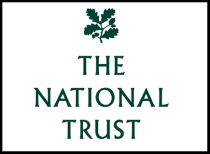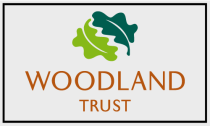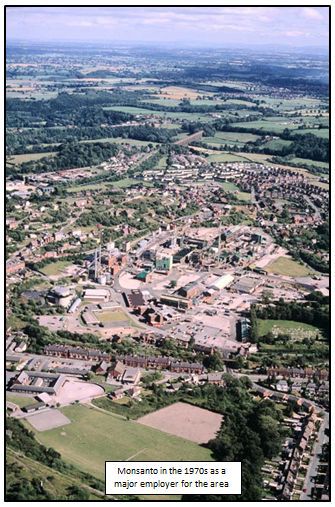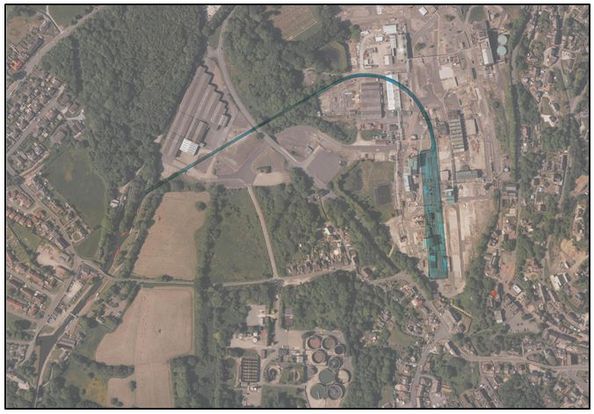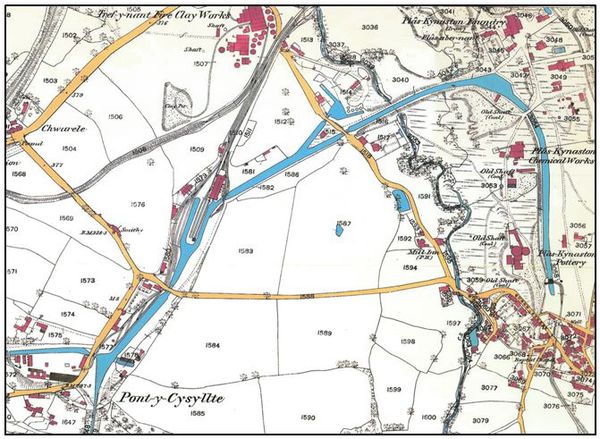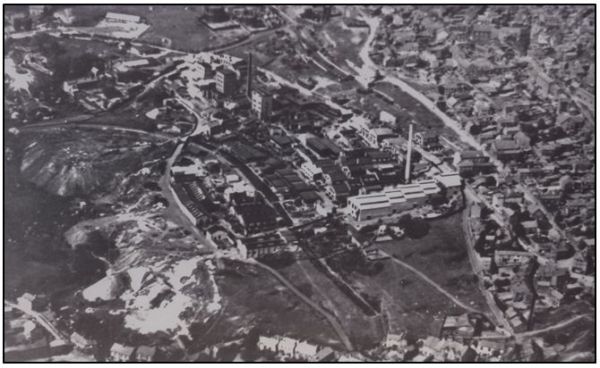Monsanto & Remediation of Cefn Mawr
Since the formation of the Plas Kynaston Canal Group in 2010, two of the leading questions asked are, what about the cost and what about the contamination of the Ex Monsanto Site. Our initial estimate of costing for the Plas Kynaston Canal was £15 million; this was for a concrete lined canal & marina, necessary when dealing with contaminated land such as in the Monsanto site and a new bridge for Queens Street to cross the canal. This was to correct the height reduction of the bridge by Monsanto in the 1960’s. It was hoped this would then have co-ordinated with the property developers working for Solutia, then site owners, under the proposed WCBC 2006-21 LDP, indicating 465 housing units. However we questioned this, and even asked for a reduction in the housing allocation as well as the inclusion of the PKC in the LDP.
Remediation, means putting right what is wrong. The site calls for Environmental Remediation, i.e. dealing with pollution and contaminants in a responsible manner and not just leaving it as is in the middle of a community and hoping for the best. So far there seem to have been three options put forward and these are as follows:
Option 1
The current situation remains the same and Eastman’s retain the Ex Monsanto site as is, fenced off indefinitely. This was suggested by Solutia at one meeting in 2010 between the PKC Group and Solutia.
However the PKC Group find this unacceptable as the Monsanto site is isolating our community from the busiest section of inland waterway network in the UK, the Llangollen Canal and the top tourist attraction in North East Wales, the Pontcysyllte Aqueduct. This is having a detrimental effect on both the health and economy of our community and is in plain violation of the Sustainable Development Charter and Future Generation Act.
We also see this option as unacceptable given the fact that the Monsanto site is immediately adjacent to the Pontcysyllte Aqueduct and the Clwydian AONB and is an eyesore and nuisance to both as well our community.
Option 2
Under this second choice the contamination once again stays where it is in the Monsanto site but is covered or capped with concrete and a large volume of “Affordable” housing units are built on top of it. The PKC Group do not view this wise because the ground remains contaminated, with all the added issues of urbanisation and associated health problems.
Option 3
Remediation, this is basically cleaning the land and dealing with the contamination of such in a responsible manner rather than just leaving it or burying it under a large housing estate.
We the PKC Group believe this is the best option for a number of reasons:
- Provide positive employment for local people.
- Provide a significant boost for the local economy.
- Isolate any problematic waste / contamination in purpose built facilities etc.
- Directly improve environmental health standards for our area.
- Raise real estate values across the board.
- Prevent contamination of water supplies, i.e. the River Dee and Llangollen Canal.
- Bring tourism directly into our community.
- Co-ordinate with UNSECO WHS status for the Pontcysyllte Aqueduct.
- Significantly reduce construction cost of the Plas Kynaston Canal & Marina
In a ballot held in 2012 we recived a clear public mandate for the Remediation of the Monsanto site in Cefn Mawr, with a vote of 99.99% in favor. This was inadditon to 2000 people signing a petition in 2010 and 1400 of our people submitting represenation for the Plas Kynaston Canal in 2011 to the WCBC.
The Monsanto Chemical Works, Cefn Mawr and the old setteling ponds in the fields below Lower Cefn next to the River Dee in the days before the Health and Safety Executive
The entire length of the Plas Kynaston Canal is within the ex Monsanto site
The Monsanto site in Cefn Mawr with a projection of the Plas Kynaston Canal & Marina
The Plas Kynaston Canal in 1875 connecting Cefn Mawr to the Pontcysyllte Aqueduct before the arrival of Monsanto
The Plas Kynaston Canal running through the Monsanto Chemical Works in 1930’s
Sustainable Development
The Welsh Government definition of Sustainable Development:
“In Wales, sustainable development means enhancing the economic, social and environmental wellbeing of people and communities, achieving a better quality of life for our own and future generations.
In ways which promote social justice and equality of opportunity; and in ways which enhance the natural and cultural environment and respect its limits -using only our fair share of the earth’s resources and sustaining our cultural legacy.
Sustainable development is the process by which we reach the goal of sustainability.”
Wales is one of only three democracies in the world with a statutory duty to promote the principles of sustainable development. The Welsh Government introduced the Sustainable Development Charter in 2012 and the Future Generations Act in 2015.
Question 1:
Of the three options you have read which equals sustainable development for our community?
Question 2:
Of the above three options which meets the requirements of the Future Generations Act?
Future Generations (Wales) Act, 2015
On the 29th April 2015 the Wellbeing of Future Generations Act became law. This Act places a duty on all public bodies in Wales to ‘carry out sustainable development’ in order to achieve the wellbeing goals of:
- A prosperous Wales;
- A resilient Wales;
- A healthier Wales;
- A more equal Wales;
- A Wales of cohesive communities;
- A Wales of vibrant culture and thriving Welsh Language; and
- A globally responsible Wales.
Planning Policy Wales edition 6 (PPW 2014) (in italics)
Provide for the conservation and, where appropriate, enhancement of biodiversity and landscape outside designated areas, in particular identifying opportunities to conserve important local habitats and species, and to safeguard and manage landscape features of major importance for nature conservation or amenity.
Make appropriate provision for Local Nature Reserves and country parks and include, where appropriate, locally-specific policies for conserving native woodland and protecting and planting trees. Clarify how biodiversity will be safeguarded outside statutory designated sites without unduly restricting development that is otherwise appropriate.
Provide for the protection and enhancement of open space of conservation value, seeking to identify opportunities to promote responsible public access for enjoyment and understanding of the natural heritage where this is compatible with its conservation and existing land uses.
Recognise the potential of, and encourage land uses and land management practices that help to secure carbon sinks.
Comment: hopefully these policies can be applied to the ex-Monsanto site to reclaim this Brownfield site back for a useful contribution to our community and the surrounding countryside. This would promote the re-introduction of wildlife within the open public space and FULL reinstatement of the Plas Kynaston Canal, tree planting and appropriate landscaping. The idea of simply fencing off the site indefinitely at the heart of our community that has a potential flood plain running through the centre leading to a major water course and immediately adjacent to a World Heritage Site and AONB is NOT TO BE PERMITTED.
Although the PKC Group is quite willing to work with the site owners for the remediation of the site and turning the site around, they will not agree to the site being maintained as is at the cost of our community. That would simply be selling out our community of the Cefn and Cefn Mawr.
Extract from the WCBC LDP2 2013 to 2028 (in italics)
Natural Environment Topic 1
Soil - Land with Contamination
The Contaminated Land (Wales) Regulations, 2006 sets out a regime to deal with contaminated land.
The Regulations place a duty on all local authorities to inspect land in their area to identify and remediate sites where contamination is causing unacceptable risks to human health and/or the wider environment using the risk assessment approach.
A number of sites have been assessed but none meet the Regulations definition of ‘contaminated land’. Land with contamination is different under the Regulations and Planning Policy to contaminated land, the latter has a strict meaning in the Regulations while the former is discussed below.
The county borough has a legacy of land contamination resulting from previous heavy industrial uses (e.g. mining, steel making, tanning) and more recent industries (e.g. munitions and chemicals), this land is spatially distributed in the areas associated with these industries, urban areas, industrial estates and the western villages.
Land with contamination does not necessarily pose a risk to humans or the environment. It is therefore not always necessary to remediate land with contamination. In fact land contamination often only creates a problem when the land is used for an unsuitable purpose and/or the contamination is so significant it is affecting controlled waters or adjacent land and/or receptors such as people and animals.
Development may open up pathways for contamination to affect people, controlled waters, animals and flora. Consequently land which has a potentially contaminative historic use, may require a Phase 1 Preliminary Risk Assessment to ensure land is suitable when developed and is managed effectively. Depending on the findings of the Phase 1 Preliminary Risk Assessment planning consent may require a Phase 2 intrusive investigation and a scheme of remediation.
This is the ex-Monsanto site at Cefn Mawr and an intrusive survey has already been conducted. This is a contaminated site in the middle of a community immediately next to the Pontcysyllte Aqueduct and Cwydian AONB at the central section of the Pontcysyllte World Heritage Site in the Dee Valley.
If this site is not remediated and redeveloped appropriately this will go against all the aspirations of the LDP2 and directives of the Welsh Assembly Government in the present round of Local Development Planning?
The Environmental Protection Act 1990 states the Local Authority is obliged to identify the appropriate person responsible. In a case where the polluter cannot be found or is no longer in existence the Act states that the liability for the clean-up or remediation lies with the current land owner or occupier of the land.
If ignored and left this will cause further hardship to the community of the Cefn and Cefn Mawr for an undetermined period in terms of both continued and unnecessary economic depression and health problems. The option for leaving the site in the currently contaminated state to the detriment of the community is not to be accepted.
The PKC Group is more than willing to work with both Eastman’s (the current site owners) and WCBC to bring about a suitable solution to the site that will meet the goals and aspirations of the SDC and LDP2 as stated. The PKC Recommendations for the LDP2 will enable the ex-Monsanto site to be turned around for the benefit of the Cefn & Cefn Mawr, the County of Wrexham, North East Wales and the Welsh Nation on a truly sustainable basis.
The PKC Group are seeking access to the URS Intrusive Survey Report. We would like access to this for a full assessment of the findings on a voluntary basis rather than having to force the issue through the freedom of information act.
So we publicly ask for this courtesy.
Area of Outstanding Natural Beauty
In March 2011 the Countryside Council for Wales (CCW) made the Clwydian Range and Dee Valley Area of Outstanding Natural Beauty (Designation) Order. The Minister for the Environment and Sustainable Development confirmed the Order on 22nd November 2011. In doing so, land including southern parts of the Clwydian Range together with the Vale of Llangollen and the Dee Valley were formally designated as an Area of Outstanding Natural Beauty (AONB).
AONB designation seeks to manage natural beauty for the benefit of social, economic and environmental wellbeing. AONB Management Plans are community led strategies implemented by partnerships of organisations and interested parties. The plans do not dictate actions within the designated areas and do not control agriculture, business or economic development activities but seek to positively manage change.
Within the existing Clwydian Range AONB a Joint Advisory Committee oversees delivery of the AONB Management Plan. The Committee comprises local authorities, organisations representing the interests of landowners and farmers, local business and groups interested in landscape conservation. A new Joint Advisory Committee has been established to cover the entire designated area in 2012. The new Advisory Committee will agree and guide the activities proposed in the Clwydian Range and Dee Valley interim statement and action plan.
The Cefn & Cefn Mawr is immediately adjacent to the AONB and the ex Monsanto site is on the very boarder of such, therefore yet another reason for turning this now unused Brownfield site around to a more appropriate use such as suggested by the PKC group. Our proposals for reinstating the Plas Kynaston Canal all the way to the Queens Hotel and new marina will coordinate well with the Llangollen Canal and the Pontcysyllte WHS as well as the AONB. This will be accompanied with open park land to the south and west of the canal with an appropriate housing development on the north side of the canal.
Built and Historic Environment Topic 2
Protection of World Heritage Sites (DCLG: 2009)
The outstanding universal value of a World Heritage Site indicates its importance as a key material consideration to be taken into account by the relevant authorities in determining planning and related applications. Any site specific proposals for an area within the World Heritage Site should have special regard for the site, its setting and buffer zone. World Heritage Site status is a key consideration and local planning authorities should aim to satisfy the following principles:
- Protect the World Heritage Site and its setting, including any buffer zone, from inappropriate development.
- Strike a balance between the needs of conservation, biodiversity, access, the interests of the local community, visitors and the sustainable economic use of the World Heritage Site in its setting.
- Protecting a World Heritage Site from the effect of changes which are relatively minor but which, on a cumulative basis, could have a significant effect.
- Enhancing the World Heritage Site where appropriate and possible through positive management.
- Protecting World Heritage Sites from climate change and ensuring that mitigation is not at the expense of authenticity or integrity.
We openly support all these policies for the protection of the Pontcysyllte Aqueduct World Heritage Site at the central section, The Cefn & Cefn Mawr and all our recommendations and proposals are designed to complement the WHS status whilst also serving the community.
The setting of a World Heritage Site is the area around it (including any buffer zone) in which change or development is capable of having an adverse impact on the World Heritage Site, including an impact on views to or from the Site. The UNESCO Operational Guidelines seek protection of the immediate setting of each World Heritage Site, of important views and of other areas that are functionally important as a support to the site and its protection.
We agree with this but also point out that more should be taken into account. Non development can also have an adverse effect by detracting from the WHS & AONB, take for instance the Ex-Monsanto Site as a prime example. Proposals that interact with the site in a positive way for the benefit of all, addressing the negative aspects should be given priority.
Cefn Mawr, the Aqueduct, Dee Valley & AONB divided by the ex Monasto site
Pontcysyllte Aqueduct and Canal World Heritage Site
The Pontcysyllte Aqueduct and Canal was inscribed by UNESCO as a World Heritage Site in June 2009. The World Heritage Site forms a linear corridor which extends from the Horseshoe Falls west of Llangollen (Denbighshire) to Gledrid Bridge to the east of Chirk Bank (Shropshire). The area inscribed within the World Heritage Site incorporates the Pontcysyllte Aqueduct and associated engineering features Horseshoe Falls, Chirk Aqueduct, the Llangollen feeder canal, cuttings, embankments and tunnels. The immediate visual setting of the Horseshoe Falls, Pontcysyllte Aqueduct and Chirk Aqueduct are also included.
The Outstanding Universal Value of the World Heritage Site is not contained purely within the inscribed area. The cultural, settled and aesthetic landscape which contribute to the presentation, setting, sense of arrival and history of the World Heritage Site are all important to the integrity of the designation. Buildings, archaeology, views and landscape features combine in places to form distinctive character and sense of place which complement the experience and understanding of the World Heritage Site.
PKC Group Fully Supports, and makes the positive contribution of prompting the remediation of the ex-Monsanto works site at Cefn Mawr.
This vacant site literally stands between Cefn Mawr and the ability to support itself on a sustainable tourism based economy in conjunction with one of North East Wales’s top tourist attractions. This immediately next to the AONB and within the Pontcysyllte World Heritage Site cannot be allowed to continue. Otherwise the LDP2 may as well be filled in the waste bin.
Sustainability means treating the earth with respect so that it is in a healthy state for future generations. It also means making wise and sometimes challenging decisions in order to achieve positive benefits in economic, social and environmental terms.
The full statement of Outstanding Universal Value for the Pontcysyllte Aqueduct and Canal and the criteria the site meets can be found at http://whc.unesco.org/en/list/1303
The former industrial village of Cefn Mawr has been identified by a number of sources including Landmap and 'An Industrial Archaeological Survey of the area around the Pontcysyllte Aqueduct and Canal' as of particular significance and even international significance, partly because of its historic relationship with the World Heritage Site, and the Pontcysyllte Aqueduct.
As a relatively well preserved example of an unplanned industrial settlement, Cefn Mawr makes a particular contribution to the understanding of the WHS and its industrial hinterland. The central area contains the Grade 2 listed Plas Kynaston Hall which was linked to the Kynaston family that owned the Plas Kynaston Foundry from where the Aqueduct's ironwork was cast.
Several of the central streets trace the line of the old industrial tramway network and it is likely that important archaeology remains beneath them. The old quarries provide visual evidence of the area's past, and the built heritage comprising a mixture of Cefn stone and Ruabon brick and terra cotta records and preserves the evolution and development of these very important historic local industries which are themselves of regional and national significance.
Please see http://plaskynastoncanalgroup.org/plas-kynaston/plas-kynaston-foundry/
The Industrial Archaeological Study of the area around the Pontcysyllte Aqueduct and Canal recommends archaeological excavation to improve interpretation of the industrial origins of the World Heritage Site, for example one of the brick works around the Cefn Mawr area (Newbridge or Acrefair) associated with the site. This would provide opportunities to improve the visitor attractions in the area and provide synergy with the regeneration of the locality.
Comment: although we see Cefn Mawr mentioned in the same section as the Pontcysyllte Aqueduct under the LDP2 we have yet to see ANY proposals or recommendations about how to unify the fragmented area. Cefn Mawr became isolated from the inland waterway network during the expansion of the Monsanto Chemical Works, back filling in the Plas Kynaston Canal Branch and closing Oily Works or Middle Road which is a part of Jessop’s Tramway and literally creating an atmosphere (HS2 releases) where people did not want to come to. Now the community of Cefn Mawr remains isolated by the vacant site which is an eye saw immediately next to the aqueduct and AONB?
The Environmental Protection Act 1990 states the Local Authority is obliged to identify the appropriate person responsible. In a case where the polluter cannot be found or is no longer in existence the Act states that the liability for the clean-up or remediation lies with the current land owner or occupier of the land.
Main Sustainability Issues Identified
- Pontcysyllte Aqueduct and Canal World Heritage Site and its Outstanding Universal Value are of international importance and require protection together with its buffer zone and attributes of value within the buffer zone.
- There are a number of areas and types of development where design needs to be particularly sensitive; Clwydian Range and Dee Valley AONB and Special Landscape Areas; historically sensitive sites (WHS, Conservation Areas, Listed Buildings etc); transitional areas between urban and rural fringes; sites adjacent key gateways and landmarks.
- Key visitor destination hubs present opportunities for sustainable tourism development.
The Cefn & Cefn Mawr should be one of these primary tourist destinations, hence maybe the wording should be Cefn Mawr and the aqueduct as it once was before Unseco Inscription?
The Aqueduct, Cefn Mawr.
The Environmental Protection Act 1990 states the Local Authority is obliged to identify the appropriate person responsible. In a case where the polluter cannot be found or is no longer in existence the Act states that the liability for the clean-up or remediation lies with the current land owner or occupier of the land.
View of Aqueduct & Cefn from Canal, before Monsanto and Unesco
Community Wellbeing and Cohesion Topic 3
Natural Environment & Public Access
The unique and inspiring natural environment of Wales offers opportunities for public access encouraging healthy activities and economic regeneration while maintaining the eco-system functions of the environment. The Countryside and Rights of Way Act 2000 opens up large areas of Wales for public access, the combined area of open country and registered common land in Wales is about 360,000 hectares, or about 20% of the land area of Wales. This offers significant opportunities for more active recreation in the countryside, as well as associated health, business and education opportunities.
Within the County Borough we have the Clwydian Range and Dee Valley AONB, Pontcysyllte Aqueduct and Canal World Heritage Site with its buffer zone. These are significant quality landscapes and heritage assets which can help address economic tourism, regeneration, education, access, recreation, health and wellbeing, sense of place, community cohesion and many other issues.
The Environmental Protection Act 1990 states the Local Authority is obliged to identify the appropriate person responsible. In a case where the polluter cannot be found or is no longer in existence the Act states that the liability for the clean-up or remediation lies with the current land owner or occupier of the land.
Facilitating public access to the natural environment is a network of footpaths, bridleways and byways. A range of former railway lines and disused land which are now inaccessible or uninviting to use could provide additional linkages facilitating public access to natural green spaces. By considering how linkages could be made or enhanced there may be opportunities for development to enhance access to natural green spaces and green networks.
Contributors to individual and community wellbeing are multi-faceted and include issues such as deprivation, poverty, unemployment, crime and safety, community spirit, Welsh language, education and skills and the built and natural environments.
Comment: this topic is called Community Wellbeing and Cohesion, firstly if the present situation of a divided community between the Trevor Basin and Cefn Mawr is not addressed and the economy of Cefn Mawr continues to fall this will only lead to further unrest and eventual anti social behaviour through social deprivation and inequality. This will detract from all the aspirations of the LDP2 and the WHS.
However if the site specific proposals of the PKC Group are adopted into the LDP2 these will unite the currently divided community and provide the economic stimulus to promote cohesion and community well being. The Cefn & Cefn Mawr is at a cross roads in its future which can either have good or bad results for both the community and WHS Inscription. We think the choice is clear.
This document calls for the Remediation of the Ex Monsanto Chemical Works site at Cefn Mawr for the benefit of the local community that have to live there.
Monsanto, Cefn Mawr Remediation 2016.pd[...]
Adobe Acrobat document [3.1 MB]


